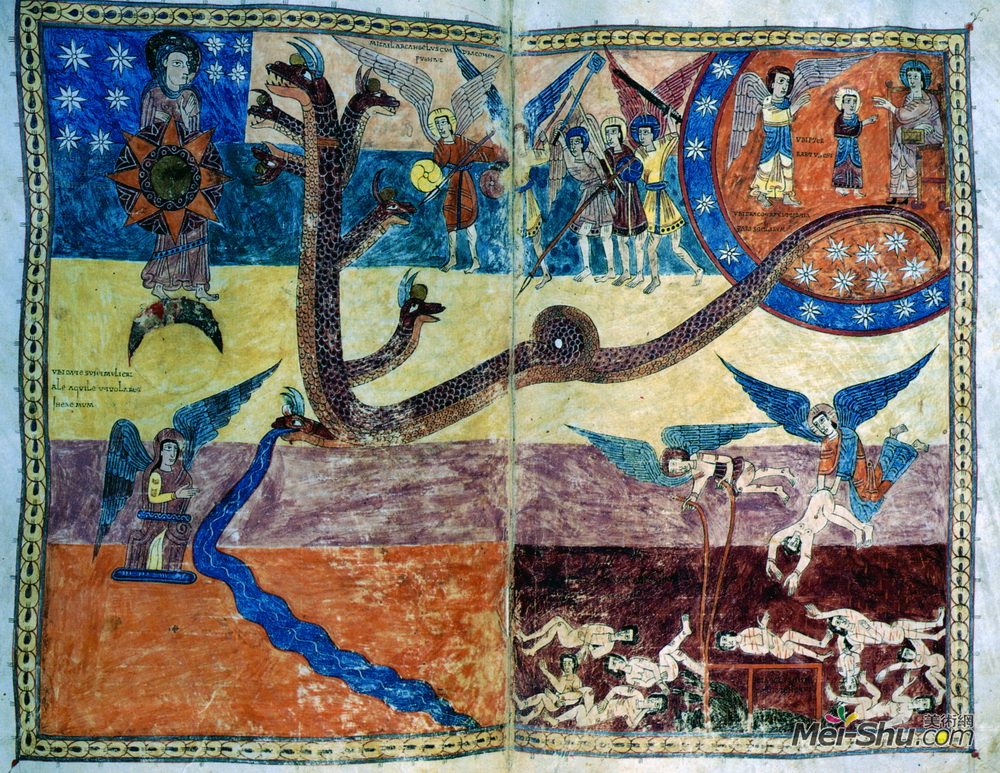 恩德(Ende)高清作品《被太阳和龙所装饰的女人》
恩德(Ende)高清作品《被太阳和龙所装饰的女人》
作品名:被太阳和龙所装饰的女人
艺术家:恩德
年代:c.975
风格:莫札拉布
类型:微型
插图涵盖两资料和描述的故事最叙事方面虽然试图合成它所呈现出的特点,首先,坐落在地球上或在地狱–中未提及的故事–在底部的一部分,和那些在天堂里发生的,在上部分。同样,同步已经显示,在蛇的情况下,一个人属于不同的时刻,可以看出它的关系到画中的其他人物。在171V上描绘的是一个女人,她的腰部有太阳形状,月亮像一个倒立的新月形部分,在她的脚边。而不是被加冕的她周围是十,不是十二,星星和她左边的传说记载:“mvlier amicta /鞋底等吕娜/ SVB pedibvs EIVS”。她旁边的龙一样大的蛇,在保持与古代的习俗,七头:大,中央有一个带齿的嘴巴张着,和三个较小的在身体的中心的一个类似的每一侧。五个头有两个角,两个有一个。每一个头上都有一个金环形状的皇冠,就像地狱里的蝗虫。最低的头吐出一股蓝色的水,周围的波浪线,像往常一样,在一个倾斜的改变原来的方向。女人再次出现在河边,用双色的翅膀坐,和传说中的“日期mvlieri /啤酒aqvile VBI svnt VT volaret / eremvm”开销。在上部的龙是由五位天使相似的外观–穿短衣服,手持盾牌、刀剑攻击,长矛和狼牙棒–即使传说为“米迦勒arcangelvs CVM dragonem / pvgnat”。他们的权利是一个大的圆包围代表天堂以天使呈现孩子的神星,有传说他们之间的阅读“VBI视图型诱发反应rabtvs EST”。上帝坐在宝座上,左手拿着一本书,伸出右手,迎接孩子。三个人物好像在对话。龙的尾巴可以在本节似乎拖七星下部分看到的,传说中的“第三traxit VBI德拉科/睫stellarvm描述”。最后,在开本的底部是一个场景,已经刊登在画报原型的事实,它出现在所有的手稿展示。它显示了作为男人没有翅膀的邪恶天使,无疑是因为在解释它们象征着邪恶,抛入地狱。在赫罗纳比特斯描绘了一个天使把人往火坑里和另一个大钳子折磨恶人一侧面表明作为一个完全变形,深色的被囚禁在一个笼或围栏,传说中“diabolvs在/医药保健品及tenetvr”。深渊,充斥着小小的红色线代表火,具有九个裸体男人在软盘的姿势却睁着眼睛代表谴责天使,与传说中的“qvos德拉科traxit天使在/ fernvm”开销。这一幕是不是由故事只描述了圣米迦勒和他的天使们对抗巨龙和邪恶的天使,后者随后被投到地球的解释,可以看出,在中世纪早期的周期在欧洲。可能有一部分是通过比较人的解释影响投了天使星的龙的尾巴拖下来,这是代表只是开销。不过,也有必要在比特斯手稿似乎影响这一场景,更大程度上考虑一定的图案元素,特别是关于恶魔拴住男人浮在地狱,这可能是在说明龙转移被捆绑并被魔鬼束缚(F.224V),描绘撒旦,囚禁在地狱中并牢牢拴住。此外,说明,遵循Victorinus Pettau的文本,强调魔鬼活着直到世界结束他的容器,即反基督的束缚。的裸体铸成永恒的折磨是在启示,欧洲版的最终判决表示回忆,在各自的插图在十世纪比特斯描绘他们以类似的方式–漂浮在地狱的天使,虽然他们是铸造缺席的这是在任何情况下的又一个标志,插图原比特斯手稿是基于一本图文并茂的解说。
Title:The woman garbed by the sun and the dragon
artist:Ende
Date:c.975
Style:Mozarabic
Genre:miniature
The illustration covers two folios and depicts the most narrative aspects of the storia although attempts were made to synthesise it, firstly, by showing the features situated on earth or in hell – not mentioned in the storia – in the bottom part, and those that occur in heaven, in the upper part. Similarly, synchronism has been used to show, as in the case of the snake, a single person belonging to several moments, as can be seen in its relationship to the other figures in the painting. Depicted on folio 171v is a woman with a sun shape at her waist and the moon, like an inverted crescent quarter, at her feet. Instead of being crowned she is surrounded by ten, not twelve, stars and the legend on her left reads: “mvlier amicta/sole et lvna/svb pedibvs eivs”. Beside her is the dragon like a large snake, in keeping with the custom of late Antiquity, with seven heads: a large, central one with a toothed mouth gaping threateningly, and three smaller ones on each side of the body similar to the one in the centre. Five heads have two horns and two have one. Upon each head is a crown in the form of a golden circle, like those of the infernal locusts. The lowest head vomits a torrent of blue water, surrounded by wavy lines set, as usual, at a slant to divert the original direction. The woman appears again next to the river, seated with two-colour wings, and the legend “vbi date svnt mvlieri/ale aqvile vt volaret/in eremvm” overhead. The dragon in the upper part is being attacked by five angels of similar appearance – wearing short garments and armed with bucklers, swords, spears and maces – even though the legend reads “michael arcangelvs cvm dragonem/pvgnat”. To their right is a large circle segment surrounded by stars representing heaven featuring an angel presenting a child to God, with a legend between them reading “vbi pver rabtvs est”. God is seated upon a throne holding a book in his lap with his left hand and stretching his right hand out to receive the child. The three figures gesture as if in dialogue. The dragon’s tail can be seen in the lower part of this section seeming to drag seven stars down, as described in the legend “vbi draco traxit tertia/pars stellarvm”. Finally, in the bottom section of the folio is a scene that already featured in the pictorial archetype, as demonstrated by the fact that it appears in all the manuscripts. It shows the evil angels represented as men without wings, undoubtedly because in the explanatio they symbolize the wicked, cast into hell. The Gerona Beatus portrays an angel throwing one of these men into Gehenna and another with large pincers tormenting the wicked one shown in profile as a totally deformed and dark-coloured being imprisoned in a sort of cage or enclosure, according to the legend “diabolvs in in-/ferno tenetvr”. The abyss, riddled with tiny, red lines representing fire, features nine naked men in floppy poses but with open eyes who represent the condemned angels, with the legend “qvos draco traxit angeli in in-/fernvm” overhead. This scene is not explained by the storia which only describes how St Michael and his angels fight against the dragon and the evil angels and how the latter are subsequently cast onto the earth, as can be seen in other early medieval cycles in Europe. It may have been influenced partly by the explanatio which compares the men cast out by the angels to the stars dragged down by the dragon’s tail, which is represented just overhead. It is however also necessary to consider certain pictorial elements in the Beatus manuscripts which seem to influence this scene to a greater extent, particularly as regards the demon tied down and the men floating in hell, which could have been transferred from the illustration showing the Dragon tied down and the devil enchained (f. 224v), depicting Satan, imprisoned in hell and fastened in the stocks. Furthermore, the explanatio, which follows the text by Victorinus of Pettau, emphasises that the devil shall live until the end of the world in his receptacle, i.e. the Anti-Christ enchained. The naked bodies cast into eternal torture are reminiscent of representations of the Final Judgment in the European version of the Revelation which, in the respective illustration in tenth-century Beatus depicts them in a similar manner – floating in hell, although the angels casting them in are absent. This is in any case yet another indication that the original Beatus manuscript with illustrations was based on an illustrated commentary.
作品名称:《被太阳和龙所装饰的女人》恩德(Ende)高清作品欣赏
作品链接:https://www.mei-shu.com/famous/27440/artistic-123907.html
作品类别:油画
免责声明:本站部分公开资料来源于互联网,目的是用于学术交流与讨论,并不代表本网赞同其观点和对其真实性负责。如果您认为我们的侵犯了您的权益,请与我们联系(banquan#mei-shu.com #替换为@),我们将在第一时间删除相关内容。